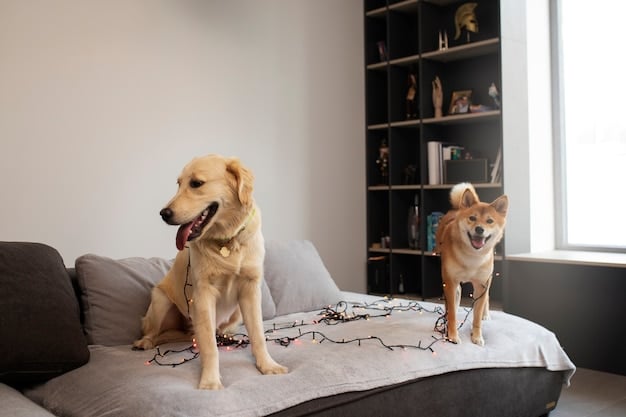Multi-Dog Harmony: Stop Fights & Lead Your Pack

Anúncios
Multi-dog household harmony is achieved by preventing fights through understanding dog behavior, establishing clear pack leadership with consistent training, and providing individual attention, ultimately creating a safe and balanced environment.
Creating a harmonious home with multiple dogs is achievable with the right approach. Multi-dog household harmony: prevent fighting & establish pack leadership involves understanding canine behavior, implementing effective training techniques, and fostering a balanced environment for each dog to thrive.
Anúncios
Understanding Canine Behavior in a Multi-Dog Home
Living with multiple dogs can be a rewarding experience, but it’s essential to understand their natural behaviors. By recognizing the dynamics that influence their interactions, you can proactively address potential conflicts.
Understanding canine behavior involves recognizing dominance displays, communication cues, and how resource guarding can impact interactions in your home. This knowledge is key to preventing fights and fostering a peaceful pack.
Anúncios
Recognizing Dominance Displays
Dominance is a natural part of canine interaction. Recognizing these displays can help you understand the pack dynamics and prevent escalation.
Interpreting Communication Cues
Dogs communicate through body language, vocalizations, and scent. Learning to interpret these cues can help you identify potential issues early on.
- Observe body posture: A dominant dog may stand tall and stiff, while a submissive dog may lower its body.
- Listen to vocalizations: Growling, barking, and whining can all indicate different emotional states.
- Pay attention to facial expressions: Lip licking, whale eye (showing the whites of the eyes), and yawning can signal stress or discomfort.

Understanding these communication cues is essential to ensuring a harmonious multi-dog household. By being able to read canine signals, you can create a proactive approach to addressing potential conflict.
Establishing Yourself as the Pack Leader
In any multi-dog household, establishing yourself as the pack leader is crucial for maintaining order and preventing fights. Your dogs need to recognize you as the authority figure who sets the rules and provides guidance.
Establishing clear leadership involves consistent training, setting boundaries, and reinforcing positive behaviors. When your dogs view you as the leader, they’re more likely to respect each other and follow your commands.
Consistent Training Techniques
Consistent training is the foundation of good pack leadership. Use positive reinforcement methods to teach your dogs basic commands and appropriate behaviors.
Setting Clear Boundaries and Rules
Dogs thrive on structure. Set clear boundaries and rules for your dogs to follow, such as where they can eat, sleep, and play.
- Establish a consistent routine for feeding, walking, and playtime.
- Use commands like “stay,” “leave it,” and “settle” to control their behavior.
- Enforce rules consistently to avoid confusion and maintain your authority.
By establishing yourself as the pack leader and providing your dogs with the structure, boundaries, and positive reinforcement, you can create a safe and comfortable environment. Clear boundaries and consistent discipline are the keys to managing a multi-dog household.
Preventing Resource Guarding Among Dogs
Resource guarding is a common issue in multi-dog households, where dogs become possessive of valuable items like food, toys, or even spaces. This behavior can lead to aggression and fights if not addressed properly.
Preventing resource guarding involves modifying behavior, managing resources, and providing a safe environment. Understanding the reasons behind resource guarding and addressing it proactively can prevent potential conflicts.
Identifying and Addressing Triggers
The first step in preventing resource guarding is to identify the specific triggers that cause your dogs to become possessive. This could be the presence of other dogs near their food bowl, a favorite toy, or a particular spot in the house.
Managing Resources Effectively
To prevent resource guarding, manage resources by providing separate food bowls, toys, and beds for each dog.
- Feed dogs separately: Ensure each dog has its own space and food bowl during meal times.
- Provide individual toys: Offer a variety of toys and rotate them regularly to keep things interesting.
- Designate personal spaces: Give each dog its own bed or crate where it can retreat and feel safe.
By effectively managing resources and addressing potential triggers, you can create a secure environment. Resource guarding is a common issue in multi-dog households, and it’s important to address it as soon as possible by following the management steps.

Introducing New Dogs to the Pack Successfully
Introducing a new dog into an existing pack requires careful planning and execution. A gradual and controlled introduction can minimize stress and prevent potential conflicts.
Introducing canines involves controlled meetings, supervised interactions, and positive reinforcement. The goal is to create a positive association between the dogs and allow them to establish a comfortable relationship.
Preparing for the Introduction
Before introducing the new dog to the pack, prepare by creating a safe and neutral environment. This could involve using separate spaces or leashed introductions.
Supervising Initial Interactions
The initial interactions between the new dog and the existing pack should be closely supervised. Keep the dogs on leashes and allow them to sniff each other in a controlled setting.
- Short, supervised sessions: Start with brief interactions and gradually increase the duration.
- Neutral territory: Introduce the dogs in a neutral location, such as a park or a large yard.
- Positive reinforcement: Reward calm and friendly behavior with treats and praise.
Successful introductions require patience, observation, and positive reinforcement. By carefully managing the initial interactions and providing ongoing support, you can help your dogs establish a harmonious relationship.
Addressing and Resolving Conflicts
Even in the most well-managed multi-dog households, conflicts can still arise. Knowing how to address and resolve these conflicts is essential for maintaining peace and harmony.
Addressing and resolving conflicts involves understanding the cause, intervening safely, and preventing future incidents. By identifying the triggers and implementing appropriate strategies, you can minimize aggression and maintain a balanced environment.
Understanding the Cause of Conflicts
To effectively resolve conflicts, it’s important to understand the underlying cause. This could be resource guarding, territoriality, or dominance challenges.
Intervening Safely
When a conflict arises, it’s important to intervene safely to prevent injuries. Avoid putting yourself in harm’s way and use appropriate methods to separate the dogs.
- Use a verbal command: A firm “no” or “leave it” can sometimes break up a fight.
- Create a distraction: Throw a blanket or pillow between the dogs to startle them.
- Use a water hose: A short burst of water can often separate fighting dogs without causing harm.
Effective conflict resolution requires a calm and controlled approach. By understanding the underlying causes, intervening safely, and implementing preventive strategies, you can minimize aggression and maintain a harmonious environment.
Providing Individual Attention to Each Dog
In a multi-dog household, it’s easy for one or two dogs to receive the majority of attention. However, providing individual attention to each dog is essential for their well-being and can help prevent behavioral issues.
Providing attention involves dedicated playtime, training sessions, and affection. Tailoring your attention to the individual needs of each dog not only strengthens your bond with them, but also helps to maintain emotional balance.
Dedicated Playtime and Training Sessions
Schedule individual playtime and training sessions with each dog. This allows you to focus on their specific needs and build a stronger bond.
Individual Affection and Grooming
Spend time giving each dog individual affection, such as petting, cuddling, and grooming. This helps them feel loved and secure.
- One-on-one walks: Take each dog for a walk by itself to provide focused attention and exercise.
- Grooming sessions: Use grooming time as an opportunity to bond with each dog and check for any health issues.
- Quiet time: Spend a few minutes each day simply sitting with each dog and offering gentle affection.
Making sure to provide consistent attention can contribute to their overall happiness and reduce the likelihood of behavioral problems. All of this leads to a more harmonious environment.
| Key Point | Brief Description |
|---|---|
| 🐶 Behavior Insights | Understand dominance, communication to prevent fights. |
| 👑 Pack Leadership | Establish rules and training for a harmonious home. |
| 🍽️ Resource Management | Manage resources like food to prevent guarding and conflict. |
| 🐾 Individual Attention | Give each dog attention to support behavior. |
Frequently Asked Questions
▼
Playful interactions usually involve loose body language, play bows, and taking turns being on top. Fighting often involves stiff bodies, snarling, and a clear intent to harm.
▼
Signs of stress include panting when not hot, lip licking, yawning, whale eye (showing the whites of the eyes), a tucked tail, and trembling. Recognizing these signs can help you intervene early.
▼
Short, frequent training sessions are more effective than long, infrequent ones. Aim for 10-15 minutes of training each day to reinforce commands and behaviors.
▼
Yes, separating dogs during feeding is highly recommended to prevent resource guarding and promote a stress-free mealtime. Provide each dog with their own space and bowl.
▼
Identify the trigger for the barking. Train a “quiet” command. Provide plenty of exercise and mental stimulation. Consider consulting a professional trainer if the problem persists.
Conclusion
Creating multi-dog household harmony: prevent fighting & establish pack leadership requires understanding dog behavior, proactive management, and proper care. By establishing yourself as the pack leader, preventing resource guarding, and providing individual attention, you can foster a positive and safe environment.






